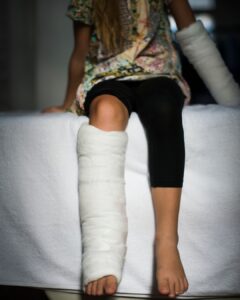H1: What You Need to Know About Leg Injuries After a Car Accident
Car accidents often inflict severe forces on the lower body, making the legs vulnerable to major injuries. Whether it’s a femur fracture, a tibial plateau fracture, ligament damage, or a crush injury, these traumas can disable you—and healing properly is vital.
At Specialty Care Clinics, we specialize in evaluating, diagnosing, and treating a wide spectrum of leg injuries, offering personalized care and rehabilitation to help you regain function, reduce pain, and prevent long-term complications.

1. Common Types of Leg Injuries From Auto Accidents
Here are the most frequently seen leg injuries caused by vehicle collisions:
- Femur Fracture (Broken Thigh Bone) – The powerful femur can break under high impact, causing disabling pain, leg shortening, and swelling
- Tibial Plateau Fracture (Bumper Fracture) – Often caused when the knee hits the dashboard, compressing the upper shinbone—commonly seen in pedestrian impacts
- Ligament Tears (ACL, PCL, MCL, LCL) – Forceful twists or direct trauma can tear supportive knee ligaments. For example, the PCL, or “dashboard knee,” often comes from backward force.
- Crush Injuries & Soft Tissue Damage – High-impact trauma can crush leg structures, injure muscles, nerves, and blood vessels, leading to complex recovery
2. Signs & Symptoms to Watch For
If you’ve been in a crash, these symptoms may indicate a leg injury:
- Intense pain, swelling, bruising, or visible deformity
- Inability to bear weight or move the limb
- Numbness or weakness from nerve involvement
- Limited range of motion or instability in the joint
Prompt evaluation is essential to diagnosing and treating leg injuries effectively.
3. Why Timely Treatment Matters
Delays in care can lead to:
- Poor healing outcomes like malunion (incorrect alignment)
- Long-term mobility loss and chronic pain
- Joint instability and early onset of arthritis
- Psychological impacts from prolonged recovery
4. How Specialty Care Clinics Treats Leg Injuries
We offer a full spectrum of care tailored to your injury’s specifics:
- Advanced Diagnostics – X-rays, CT, or MRI imaging for accurate diagnosis
- Immobilization or Stabilization – Casting or surgical intervention depending on severity
- Surgical Repair – Rods, plates, or screws for fractures; ligament reconstruction when needed
- Rehabilitation & Physical Therapy – Personalized programs to rebuild strength, flexibility, and mobility
5. Recovery: What to Expect
- Emergency Evaluation – Immediate diagnosis and stabilization
- Surgical or Non-Surgical Management – Based on your injury type
- Physical Therapy & Rehab – Progressive recovery from strength to functional movement
- Long-Term Monitoring – Preventing relapses or complications like arthritis
Our goal is to ensure your return to daily life is as smooth and pain-free as possible.
Conclusion
Leg injuries from car accidents—whether it’s a femur fracture, ligament tear, or crush injury—can significantly impact your life. But with expert care, modern treatment, and comprehensive rehabilitation, full recovery is achievable.
At Specialty Care Clinics, we are dedicated to providing the expert care you need to walk your recovery path with confidence.
Need Leg Injury Treatment?
Visit: Specialty Care Clinics – Leg Injury Treatment
Call: (972) 865-4454
Frequently Asked Questions
- What Is a Tibial Plateau Fracture?
A fracture of the upper tibia, often resulting from dashboard impact—can affect knee stability. - What Makes ‘Dashboard Knee’ Unique?
It’s a PCL injury caused by force from the shin being pushed backward during a crash. - How Long Does a Femur Fracture Recovery Take?
Femur breaks require months of healing and rehab due to the bone’s size and load-bearing role. - Can Ligament Tears Heal Without Surgery?
Minor tears may heal with immobilization and therapy, while severe tears often require reconstruction. - Are Leg Injuries Common in Every Crash?
Yes—given their proximity to impact and pedal areas—leg injuries are among the most frequent in auto collisions.
